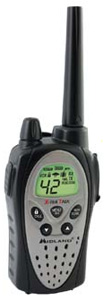Most of Motorola's new 2008 consumer (FRS/GMRS) radios are now in stock and ready to ship! There are a couple of unique innovations within this series that I think will win Motorola quite a few new customers this year. Let's take a closer look at the two biggest advances.
Emergency Kit Radios
The biggest innovation is the Motorola EM1000R and EM1000 radios. These radios have features designed specifically to be of use during an emergency. When held for 3 seconds, an Emergency Alert Button will send an 8 second distress alarm alert to all other radios within range. If there are other EM1000 radios within range, they will increase their volume level to the maximum upon receiving a distress call. The radio will then automatically go into hands-free transmit mode for 22 seconds.
The EM1000 also has an LED flashlight built-in. The LED for the flashlight is on the bottom of the radio with the button to turn on the light located under the push-to-talk (PTT) button.
This model supports NOAA weather channels and weather alerts, as well.
With these features the EM1000 or EM1000R will definitely become the logical choice for those putting together an emergency kit. They will also be a consideration for anyone looking for radios for a typical use, such as a cruise or a road trip, but want to keep the radios handy in case of emergencies after their primary use is over.
USB Charging Port
Except for the very low end FV300 and FV300R, all of the new Motorola radios are equipped with a mini-USB port that can be used for charging the radio. There are over 100 million USB cables in use now, and most everyone has on charging a cell phone, MP3 player or some other small device. This same cable can be used to charge your new Motorola two way radio! This is a definite convenience, but it also gives people who need to keep both radios in a different location a charging option. A single two pocket charger doesn't help much when you need to keep one radio upstairs and another down! A cheap USB cable now solves this problem.
New Models
Here is a list of all of the new models, with the top features of each.
T9650RCAMO - Value pack that will include two T9650 radios (similar to T9550), two earpieces with boom mic's, and vehicle charger. Available in May.
T9680R-SAME - Top of the line model. Replaces the T9580R-SAME but adds the USB charging port. Supports advanced S.A.M.E. weather alerts. Available in June.
EM1000R - Emergency alert button, flashlight, USB charging port, VOX hands-free use, NOAA weather channels and alerts.
EM1000 - Identical to the EM1000R, but doesn't include rechargeable batteries/charger. Each radio requires 3 AA batteries.
SX900R - NOAA weather channels and alerts, VOX hands-free use, USB charging port.
SX600R - VOX hands-free use, USB charging port. The packaging claims this model has less power than the SX900R, but this does not appear to be the case.
FV300R - Small and lightweight. Includes pig-tail charging adapter (no charging cradle).
FV300 - Small, low cost radio. No charger is included. Each radio requires 3 AAA batteries.
Discontinued Models
As new models are brought in, old ones are phased out. The following models are no longer being produced by Motorola: T9580R-SAME, SX800R, FV800R, T5000R, T5500AA, FV200.
Congratulations to Giant International, manufacturer of Motorola consumer radios, for some great innovations in this 2008 lineup!
 Customers who are new to business radios are confronted with several confusing options, one of which is the type of frequency band to choose. This particular option consists of two choices, either UHF or VHF. These abbreviations make no sense to most people and without some research it is easy to choose a radio that is not right for your situation. So how do you determine which is the best choice for your application?
Customers who are new to business radios are confronted with several confusing options, one of which is the type of frequency band to choose. This particular option consists of two choices, either UHF or VHF. These abbreviations make no sense to most people and without some research it is easy to choose a radio that is not right for your situation. So how do you determine which is the best choice for your application?






